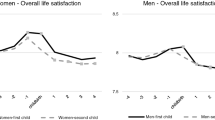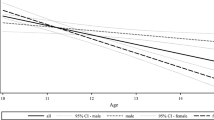Abstract
We investigate the relationship between having children at home and life satisfaction. Contrary to much of the literature, our results are consistent with an effect of children on life satisfaction that is positive, large and increasing in the number of children. The effect, however, is contingent on the individual’s characteristics. In particular, our findings are consistent with children making married people better off, while most unmarried individuals appear to be worse off with children. We also analyze the role of factors such as gender, age, income and education.
Similar content being viewed by others
Notes
The terms “life satisfaction” and “happiness” tend to be used interchangeably in the literature. Our data refers to life satisfaction and we will use this term throughout most of the paper, but some discussions of the literature will use the term happiness instead. It is useful to note that surveys with questions on both life satisfaction and happiness show a high correlation between the two variables.
All correlations are statistically significant at the 1% level.
The equivalence scale is described in Taylor (2007). We adjust for inflation using the UK’s CPI from the Office of National Statistics.
A second explanation for the differences may be hedonic adaptation. As shown most recently by Clark et al. (2008a) and Angeles (2009), individuals tend to “adapt” to many life events like changes in marital status or in health. In other words, the effect of such changes is high in the years immediately after they take place but tends to dissappears in the long run. In a panel with a relatively limited time dimension the effect of a given shock would be estimated using observations that take place shortly before and after the shock. This would explain why the coefficient on widowhood is large and negative under fixed effects: unlike the OLS coefficient, it is capturing the early years following the death of a spouse.
Through most of this paper we will be concerned with the size of the effect of children on life satisfaction. We will consider that an effect is large if it is in the same league as the effects of marriage, unemployment and health. Taking the results from the second column of Table 3 as a benchmark, the effect of marriage on life satisfaction is 0.178 units, the effect of unemployment is −0.294 and the effect of increasing health status by one in the five-level scale is about 0.250. Thus, we regard an effect in the 0.200−0.300 range as large.
The group “never-married singles” was obtained by taking the persons described as “never married, not in a couple” and considering only the individuals who are catalogued as head of household. The reason is that many of the individuals who have never married, are not living as a couple and who are not heads of household will be actually grown-up children of the household head and the children living in the household will probably be their siblings.
We may note at this point that Kohler et al. (2005) found that the interaction between the dummy variables for “having at least one child” and “being in a partnership” had no effect on happiness. This may be explained by the fact that in their study a “partnership” may refer to an unmarried couple. As our results from Table 4 make clear, married and unmarried couples experience parenthood markedly differently.
The effect of having four or more children is much larger but one has to consider that having four or more children before the age of 30 is a rather rare occurrence.
A related result is obtained by Kohler et al. (2005), who find a positive effect of children on happiness when their sample includes individuals aged 25–45 but no effect with individuals aged 50–70.
References
Alesina, A., Di Tella, R., & McCulloch, R. (2004). Inequality and happiness: Are European and Americans different? Journal of Public Economics 88, 2009–2042.
Angeles, L. (2009). Adaptation and anticipation effects to life events in the United Kingdom. Department of Economics, University of Glasgow, discussion paper 2009-08.
Blanchflower, D. G. (2008). International evidence on well-being. NBER working paper 14318.
Clark, A. E. (2006). Born to be mild? Cohort effects don’t explain why well-being is U-shaped in age. Working paper 2006-35, Paris-Jourdan Sciences Economiques.
Clark, A. E., Diener, E., Georgellis, Y., & Lucas, R. E. (2008a). Lags and leads in life satisfaction: A test of the baseline hypothesis. The Economic Journal 118, F222–F243.
Clark, A. E., Frijters, P., & Schields, M. A. (2008b). Relative income, happiness and utility: An explanation for the Easterlin paradox and other puzzles. Journal of Economic Literature 46(1), 95–144.
Clark, A. E., & Oswald, A. J. (2002). Well-being in panels. Mimeo.
Di Tella, R., MacCulloch, R., & Oswald, A. J. (2003). The macroeconomics of happiness. Review of Economics and Statistics 85(4), 809–827.
Frey, B., & Stutzer, A. (2000). Happiness, economy and institutions. The Economic Journal 110, 918–938.
Frey, B., & Stutzer, A. (2006). Does marriage make people happy or do happy people get married? The Journal of Socio-Economics 35, 326–347.
Gilbert, D. (2006). Stumbling on happiness. London: Harper Press.
Goldberg, D. P. (1972). The detection of psychiatric illness by questionnaire Mansley monograph no 21. London: Oxford University Press.
Goldberg, D. P., & Williams, P. (1988). A user’s guide to the General Health Questionnaire. Windsor: NFER.
Haller, M., & Hadler, M. (2006). How social relations and structures can produce happiness and unhappiness: An international comparative analysis. Social Indicators Research 75, 169–216.
Kahneman, D., Krueger, A. B., Schkade, D. A., Schwarz, N., & Stone, A. A. (2004). A survey method for characterizing daily life experience: The day reconstruction method. Science, 306(5702), 1776–1780.
Kohler, H., Behrman, J. R., & Skytthe, A. (2005). Partner + children = happiness? The effects of partnerships and fertility on well-being. Population and Development Review 31(3), 407– 445.
Layard, R. (2005). Happiness: Lessons from a new science. New York: The Penguin
Nomaguchi, K. M., & Milkie, M. A. (2003). Costs and rewards of children: The effects of becoming a parent on adults’ lives. Journal of Marriage and Family 65, 356–374.
Taylor, M. F. (Ed.). (2007). British household panel survey. Users manual volume A: Introduction, technical report and appendices. Colchester: University of Essex.
Acknowledgments
I thank Robert A. Cummins and four anonymous referees for helpful comments and suggestions. All remaining errors are of course mine. The paper is dedicated to L. S. Angeles.
Author information
Authors and Affiliations
Corresponding author
Additional information
An erratum to this article can be found at http://dx.doi.org/10.1007/s10902-010-9196-8
Rights and permissions
About this article
Cite this article
Angeles, L. Children and Life Satisfaction. J Happiness Stud 11, 523–538 (2010). https://doi.org/10.1007/s10902-009-9168-z
Published:
Issue Date:
DOI: https://doi.org/10.1007/s10902-009-9168-z




